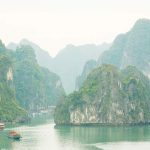Location
In Quang Ninh province northeastern Vietnam
Area:
157.83 sq km
Date declared as an AHP:
30 September 2016
Contact information
Mr Nguyen Thanh Phuong
Unique Flora: Mangrove ecosystems are distributed (ang Cai Lim), being evaluated as the most unique in Southeast Asia in terms of ecology, science, education, and training. Evidences of one remarkable ecological process have been observed at the site – the formation of Tung Ang ecosystems. The process involves the convergence of sea water and freshwater that results to the formation of brackish water. Old growth mangrove forests thrive in these Tung Ang ecosystems.
Unique Fauna: Bai Tu Long National Park is a breeding ground for many rare and endangered species including the green-billed sea turtle.
Habitat Types: North of the Island – “mountain land” on the terrigenous rock (including sandstone, conglomerate, arkose) accounting for nearly one third of the island (over 400 ha);
South of the island – limestone mountains characterized by Karst topography with many caves and “tung ang” (flooded valley farms) (over 1,100 ha); Mangrove ecosystems are distributed (ang Cai Lim), being evaluated as the most unique in Southeast Asia in terms of ecology, science and education and training
Fish farming and harvesting as well as everyday activities of local people show a number of unique cultural features of the coastal areas and islands.






